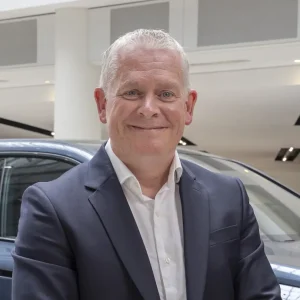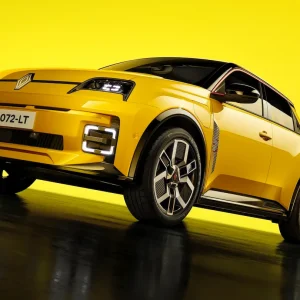Since replacing the Europe-bound Kevin Griffin as Ford of Britain’s fleet operations director in January, Phil Hollins has been as busy as you’d expect the man heading the UK’s biggest-volume business car manufacturer to be.
The Mondeo has been one area of focus, both in current and future form. Ford revealed the next-generation at the Detroit motor show in January 2012, but is closing the European plant in Genk, Belgium, that currently builds the car, moving production to Valencia. The decision has knocked back the launch significantly and it won’t now arrive in the UK until at least the end of next year.
That has meant another update for the current car, with Ford announcing in April new Titanium X Business Edition and Graphite models, as well as a 10g/km CO2 reduction on 2.0-litre 163hp and 140hp versions, taking them down to 119g/km. The Titanium X Business Edition gets navigation, Bluetooth and a range of higher-spec equipment, while the Graphite, starting from below £16,000, still offers alloys and Bluetooth.
“The biggest factor in this sector is CO2, and what we were able to do is significant; [we] combined [that] with the Business Edition that gets navigation – that’s a big thing and a very visible feature that’s well received in the marketplace,” Hollins tells BusinessCar.
Hollins has had to contend with large supply shortages this year, thanks to the consultation around the Genk closure that disrupted production of the Mondeo, S-max and Galaxy, although it’s the Mondeo that has been worst affected.
“We’re now seeing cars coming through; in quarter one we had massive supply issues with the Mondeo and we’ve got a lot of pent-up demand in distribution,” says Hollins. “Lead times are larger than we would like but the car provides a great bridge through to the back-end of 2014 when we will be in a position to launch the new one.”
The new model has also been delayed by the Genk closure, with production shifting to Spain, but Hollins doesn’t feel the hold-up will be costly.
“There was a school of thought that said you should never talk about new until you have sold all of the old cars, but the customers are very different. It’s a different financial equation: people will pay more for a new car than they are prepared to pay for the current one,” he explains. “I’m okay that we will deliver our volume commitments on the Mondeo despite the Genk changes and extended run-out. We’ve now got a product and price proposition that is attractive and I’m seeing that in my order bank. I know how many orders I’m sitting on and I’m in pretty good shape.”
The Focus range, now established in the market since the new model’s 2011 launch, is also about to get some headline-grabbing additions with efficiency in mind. First comes the Econetic version, offering 88g/km of CO2 and an official fuel figure of 83.1mpg. “For a number of customers it’s the car of choice, so it’s a headline, but it’s also a real volume product,” explains Hollins. “[But] if I were to talk about the Focus Electric then that’s more about headline than volume.”
The first Focus Electric rolled off the factory production line earlier this month, with cars getting to the UK later this summer, although Ford is still debating how to market the car
in the UK. “We will look for targeted opportunities to get more than just a sale. It won’t be sold like any other car,” says Hollins. “Options are still on the table at the moment. With the volume it is, it will get a residual value, but I think it’s of limited interest to the wider lease company schemes.”
The Focus Electric is the first venture into the world of ultra low-emission vehicles and will be followed by the C-max Energi plug-in hybrid next year and a conventional Mondeo hybrid in 2015, although Ford is also developing a hybrid C-max and plug-in hybrid Mondeo that aren’t yet confirmed for the UK.
Another of Hollins’ tasks is to expand Ford’s volume base.
“The observation I had after three months was that most conversations in Ford fleet centred around four products – the Fiesta, Focus, Mondeo and Transit – and as the market sub-segments there are more opportunities than these four,” he declares. “I’m looking to make sure we utilise the whole platform from the Max family though the Kuga and Galaxy to the Tourneo, and I’m looking to grow these products.”
Rather than a traditional 200,000 registrations per year split across the four core models, Hollins is looking for “more lumps of 5000-10,000” units as the brand and the market continue to evolve.
New focus on SMEs
Early next month, Ford’s fleet boss Phil Hollins will launch a new SME initiative to the firm’s dealers, hoping to get them “more engaged” in selling to local fleets.
“It will build on the solid base we have and use the tools available to us, because I think the market will sub-segment more and more and we need to find ways to deliver higher volumes in smaller chunks than before,” Hollins tells BusinessCar. “It’s not a revolution but an evolution of where we were before. It’s a package of benefits for dealers who want to operate in a certain way.”
He says there won’t be pressure on all of the dealers to take part, but he adds fleet cars are already coming through dealers in some ways, so there’s more margin available for the ones who wish to get involved.
“There needs to be a mechanism whereby, if the fleet guy isn’t in the dealer when an SME walks in he gets treated appropriately, and we have a plan to do that,” continues Hollins. “It is an opportunity, relatively slow-burn, but if we can continue to demonstrate progress we’ll continue to invest in it and give benefits to the SME customers they [dealers] deal with.”





